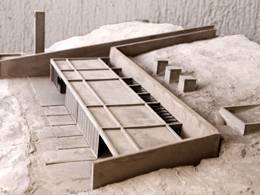STUDENTS PROJECTS
PROJECTS 2011

31 March, 2012
Production line at Schinousa island
Cheese factory - bakery - restaurant - store. Production based on tradition.
Students: Nomikou Kaliope, Raftopoulou Natalia - Christina
Supervisor: Papaioannou T.
School Of Architecture NTUA
Date: 5/12/2011
The design of a complex composed of production spaces, where the traditional production process meets the needs of the present, aims at the designation of the island through the products that the land and locals produce. Necessary condition while planning is the interpretation of the landscape and the integration into it.

On a small island of Cyclades, called Schinousa, the agricultural factor designates its nature essence and specifies the local economy. For that reason we choose to create a traditional cheese factory, a restaurant were local eating is provided, a bakery with wooden stove and a shop that sells the regional products. Common organized activity doesn't exist at Schinousa and its attainment would preserve the locals, create financial motivations and contribute at the reinforcement of the island.
On a morphological level, the designing process depends on the observation and analysis of the region. Our design intention is the conservation of the islands physiognomy (texture, scale, and materiality), the exploitation of the particular topography (orientation, relief, view) and also the wise handling of the selected area (existing buildings, access routes, alignments).
The location of the plot is also symbolic. We intervene in a rural area, but also close to the center of the island, called Panagia. Installation near the source of the raw material ensures quality and reduces the cost. Furthermore, the proximity to an area of touristic interest, close to the new port enhances traffic and ensures sustainability. Moreover, the characteristics of the land, the generous view and the existing shells defined the selection of the site. On the upper part of the plot, beside the threshing floor, stands the old flour-mill, distinctive characteristic of the island. Along with subsequent rural facilities, create an harmonic whole at the top of the hill.

An essential step is the preservation and enhancement of the mill, the threshing floor and the dry-rubble stones at the plots boundaries, as they are man-made interventions at the landscape with great importance. We suggest the restoration of the flour-mill, to enhance production and to connect the agricultural past with the proposed functions. From the rest existing shells we decide that the old warehouse meets the needs of a small store, while the sheepfolds are demolished in order to reuse their materials.
The complex is located in reference to the mill, while the functional order of each unit turns to a different viewpoint. The surrounding area remains barren and unrefined, while the gravel paths that the human footprint mapped out over the years, maintain and emerge. The exploitation of the landscape to the strict minimum preserves the character of the area. The ground is left untouched to flow over so that the slope drops, opening to the sea view. The resulting forms are defined by simple lines, clear geometry and retain the human scale. The use of local materials, mainly stone, combined with modern, reflects the materiality of the landscape and aims to the integration into it.
The main concept is the creation of a line, which is defined by the existing structures and will also include the new ones. The two basic accesses at the study area, the one from "Panagia" village and the other from the new port, shall assign the ends of the line and simultaneously signify the allocation of functions to them. Small-scale commercial and productive uses are placed on the upper plot, ensuring the conceptual continuity of the village. The store, restaurant and bakery, along with the mill and the threshing floor, create a vibrant insular whole. Instead, the major unit of the traditional cheese factory is isolated in the lower plot as disturbing use and also to cover the need for direct service through the main road.


A strict line that unifies the seemingly independent and remote functions was chosen as a design principal. A conceivable axis, a "production line", connects the centers of the mill and threshing floor, expands and defines the spatial placement of the cheese factory. The axis is implemented as a linear walking route that ends to the cheese factory and ensures the visual contact between mill - cheese factory. The route is shaped by two walls that come into from the ground and grow into long, strong stone walls, turning motion into building. One wall wraps and defines the form and extent of the cheese factory, while the other has a short building edge (boiler room) that offers micro scale and liberates the movement.
The cheese factory has a south-facing orientation and also uses the slope of the plot to provide spaces below the surface of the ground. The design of the production unit will be determined by the functional requirements and the necessary equipment. The production of cheese indicates the required spaces (receiving, cheesemaking, storage) and the layout. A linear building is designed supported by the functional corridor that runs throughout its length. The corridor is defined by the strong folding retaining wall that isolates the underground spaces (salting, ripening, drainage and conservation) in order to fully exploit the earth conditions. Skylights, air ducts and semi-open spaces (collecting milk, loading- unloading goods) ensure natural lightening and ventilation and complete the composition. A special morphological feature is the chimney of the boiler room where the burning of the whey is taking place for the protection of soil toxicity. The chimney provides a strong vertical counterpoint that balances the horizontal surfaces.















